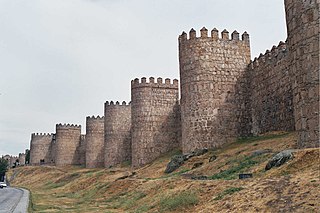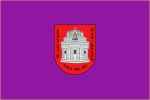Ávila: Difference between revisions
No edit summary |
|||
| Line 90: | Line 90: | ||
}} <!-- Infobox ends --> |
}} <!-- Infobox ends --> |
||
'''Ávila''' |
'''Ávila''' ([[Latin language|Latin]]: ''Abila'' and ''Óbila'') is a [[Spain|spanish]] city located in the [[Autonomous communities of Spain|autonomous community]] of [[Castile and Leon]], capital of the [[Province of Ávila|homonymous province]]. |
||
«Ávila de los Caballeros» is an honorific title of the city. Another is «Ávila del Rey» and yet another «Ávila de los leales» are all present in the flag of the city. |
|||
The city is notable for having a complete [[Middle Ages|medieval city walls]], [[Romanesque art|romanesque]]. |
|||
It is also one of the cities with the highest number of churches ([[Romanesque art|romanesque]] and [[Gothic architecture|gothic]]) and catering establishments in relation to the number of its inhabitants. |
|||
It is considered by many as the city of «Song and Saints». It said the writer José Martínez Ruiz [[José Martínez Ruiz|Azorín]], after writing «The Castilian Soul» which was «perhaps the most 16th century city of Spain». |
|||
==Geography== |
==Geography== |
||
Revision as of 22:48, 8 October 2010
You can help expand this article with text translated from the corresponding article in Spanish. (December 2009) Click [show] for important translation instructions.
|
Ávila
Ávila de los Caballeros Ávila del Rey Ávila de los leales | |
|---|---|
Ávila with its famous city walls, as seen from a distance | |
| Motto(s): | |
| Country | Spain |
| Autonomous Community | Castile and León |
| Province | Ávila |
| Government | |
| • Mayor | Miguel Ángel García Nieto (PP) |
| Area | |
| • Land | 231.9 km2 (89.5 sq mi) |
| Elevation | 1,182 m (3,665 ft) |
| Population (2009) | |
| • Total | 59,272 |
| • Density | 226.87/km2 (587.6/sq mi) |
| Time zone | UTC+1 (CET) |
| • Summer (DST) | UTC+2 (CEST) |
| Postal code | 05001 - 05006 |
| Area code | 34 (Spain) + 920 (Ávila) |
| Website | http://www.avila.es Template:Es icon |
Ávila (Latin: Abila and Óbila) is a spanish city located in the autonomous community of Castile and Leon, capital of the homonymous province.
«Ávila de los Caballeros» is an honorific title of the city. Another is «Ávila del Rey» and yet another «Ávila de los leales» are all present in the flag of the city.
The city is notable for having a complete medieval city walls, romanesque.
It is also one of the cities with the highest number of churches (romanesque and gothic) and catering establishments in relation to the number of its inhabitants.
It is considered by many as the city of «Song and Saints». It said the writer José Martínez Ruiz Azorín, after writing «The Castilian Soul» which was «perhaps the most 16th century city of Spain».
Geography
The city is 1131 meters (3665 feet) above sea level, the highest provincial capital in Spain. It is built on the flat summit of a rocky hill, which rises abruptly in the midst of a veritable wilderness: a brown, arid, treeless table-land, strewn with immense grey boulders, and shut in by lofty mountains. This results in an extreme climate, with very hard and long winters, and short summers.
History

In pre-Roman times (5th century BC), it was inhabited by the Vettones, who called it Obila ("High Mountain") and had here one of their strongest fortresses.
Ávila may have been the ancient town known as Abula, mentioned by Ptolemy in his Geographia (II 6, 60) as being located in the Iberian region of Bastetania.[1] Abula is mentioned as one of the first cities in Hispania that was Christianized, specifically by Saint Secundus (San Segundo).[1] However, Abula may have been the town of Abla.[1] After the conquest by the Romans, it was called Abila or Abela. After the fall of the Western Roman Empire, Ávila was a stronghold of the Visigoths. Conquered by the Arabs (who called it Ābila, آبلة), it was repeatedly attacked by the northern Iberian Christian kingdoms, after which it remained virtually uninhabited. It was repopulated in the 11th century, after the definitive capture of the area by the Christians, under Raymond of Burgundy.
The city lived a period of prosperity under the Catholic Kings (early 16th century) and their successors Charles V and Philip II of Spain, but decayed again starting from the 18th century, when it reduced to just 4,000 inhabitants.
Main sights


Ávila is most known for the medieval city walls[2], that were constructed of brown granite in 1090: surmounted by a breastwork, with eighty-eight towers and nine gateways, they are still in excellent repair, but a large part of the city lies beyond their perimeter.
The Gothic cathedral is integrated into the city's defences. It was built between the 12th and 14th centuries, and has the appearance of a fortress, with embattled walls and two solid towers. It contains many interesting sculptures and paintings, besides one especially fine silver pyx, the work of Juán de Arfe, dating from 1571.
The churches of San Vicente, San Pedro and San Segundo are, in their main features, Romanesque of the 12th century. The Don Diego del Águila date to the 16th century.
In the Gothic Monastery of Santo Tomás, erected by the Catholic Queen Isabella in 1482, is especially noteworthy the marble monument, carved by the 15th-century Florentine sculptor Domenico Fancelli, over the tomb of Prince John, the only son of Ferdinand and Isabella.
Food

Typical food in Ávila includes roast lamb, suckling pig, and veal steak. Ávila is also famous for its yemas de Santa Teresa - egg yolk candies named after the patron saint.
Characteristic dishes include Beans Avila del Barco, Avila-bone steak, potatoes and yolks revolconas St. Teresa. Also worth mentioning hornazo, bread roll stuffed with sausage, bacon, tenderloin and eggs, veal sweetbreads or suckling pig, cuchifrito in the capital and baked in Arevalo.
The Santa Teresa yolks are sweet typical of the city, manufactured in the traditional pastry "La Flor de Castilla". The rest of bakeries in the city but also manufactured under the name "Egg of Avila," or simply "buds", is produced as the name suggests from the yolk.
| UNESCO World Heritage Site | |
|---|---|
 | |
| Criteria | Cultural: iii, iv |
| Reference | 348 |
| Inscription | 1985 (9th Session) |
Town twinning
Gallery
-
Complete view of the Walls of Ávila.
-
Other view of a part of the walls.
-
Northwest side of the Walls of Ávila.
-
Ávila on winter (2005 february)
-
Cathedral of Ávila, built between the XI and XV centuries.
-
View of northern facade of the Cathedral of Ávila.
-
Apse of the Cathedral of Ávila.
-
Basílica de San Vicente (western facade), built between the XII and XIV centuries.
-
Basílica de San Vicente.
-
Convento de Santa Teresa.
-
La Plaza de Santa Teresa, both with the San Pedro Church.
-
Santa Teresa´s feast day (2007).
-
Monasterio de Santo Tomás.
-
San Pedro Church, founded in the year 1100.
-
Real Monasterio de Santo Tomas.
-
Sanctuary of Nuestra Señora de Sonsoles.
-
Roman monument know as «Los Cuatro Postes»
-
Roman ruines.
-
Inscription dedicated to G. Antonius daugeti filius in the wall of the city.
-
Plaza del Mercado Chico, a medieval market.
-
Principal building of Catholic University of Ávila.
-
Ayuntamiento.
-
Jardín de El Soto.
See also
References
External links
- Avila's City Hall
- Avila's Tourist Guide
- Convent of St. Teresa, Avila
- Photos of Avila
- Satellite picture by Google Maps
- Hazlitt, Classical Gazetteer "Abila"
- Citizens' association for the defence of heritage of Avila - Photos of Avila
- This article incorporates text from a publication now in the public domain: Chisholm, Hugh, ed. (1911). Encyclopædia Britannica (11th ed.). Cambridge University Press.
{{cite encyclopedia}}: Missing or empty|title=(help)























